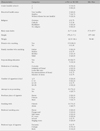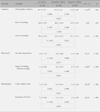Abstract
Purpose
The purpose of this study was to examine the effects of a smoking cessation program using self-regulated learning strategy as an approach for middle-school boys to stop smoking.
Methods
A one group time series study was utilized for the purpose of this study. A five-week smoking cessation program, based on the self-regulated learning strategy of Zimmerman (1989), was provided to 15 middle-school boys who were smokers. Data were collected from July to September, 2008 and analyzed using descriptive statistics, repeated measures ANOVA, and nonparametric test, Friedman, 2 related samples with SPSS/WIN 14.0 program.
Results
Following the intervention, the participants showed significant differences on self-regulatory efficacy, cons of smoking, stage of smoking behavior change, nicotine dependency, urine cotinine levels, and CO expiration levels compared to those at pretest and those differences remained at 5 months after the intervention, except cons of smoking.
Conclusion
This study suggest that the smoking cessation program using self-regulated learning strategy is effective for smoking cessation in middle-school boys and those smoking cessation behaviors remained for up to 5 months after the completion of the intervention. Broad application of the program would be beneficial for teenagers who smoke.
Figures and Tables
References
1. Ahn HK, Lee HJ, Jung DS, Lee SY, Kim SW, Kang JH. The reliability and validity of Korean version of questionnaire for nicotine dependence. J Korean Acad Fam Med. 2002; 23:999–1008.
3. Chang SO, Kim EJ, Kil SY, Seomun GA, Lee SJ. Influential variables on intention and action to quit smoking between adolescent smokers and adult smokers-based on the transtheoretical model. J Korean Acad Nurs. 2005; 35:1410–1419.

4. Chang SO, Park YJ, Park CS, Lim YJ. A study of the stage of change and decisional balance: Exercise acquisition, smoking cessation, mammography screening, and Kegel's exercise acquisition in Korea. J Korean Acad Nurs. 2000; 30:1265–1278.

5. Chassin L, Presson CC, Sherman SJ, Edwards DA. The natural history of cigarette smoking: Predicting young-adult smoking outcomes from adolescent smoking patterns. Health Psychol. 1990; 9:701–716.

6. Cho DY. Behavioral Science. Seoul: Ilchokak;2001.
7. Choi JS. The effects of smoking cessation program applying the cognitive behavior therapy. Seoul: Seoul National University;1998. Unpublished doctoral dissertation.
8. Cohen J. Statistical power analysis for the behavioral sciences. 2nd ed. Hillsdale, NJ: Lawrence Earlbaum Associates;1988.
9. DiClemente CC, Prochaska JO, Fairhurst SK, Velicer WF, Velasquez MM, Rossi JS. The process of smoking cessation: An analysis of precontemplation, contemplation and preparation stages of change. J Consult Clin Psychol. 1991; 59:295–304.

10. Epstein JA, Griffin KW, Botvin GJ. A model of smoking among. inner-city adolescents: The role of personal competence and perceived social benefits of smoking. Prev Med. 2000; 31:107–114.

11. Gulliver SB, Hughes JR, Solomon LJ, Dey AN. An investigation of self-efficacy, partner support and daily stress as predictors of relapse to smoking in self-quitters. Addiction. 1995; 90:767–772.

12. Han SS, Lee SC, Koo JC. Health & medical statistical analysis. Seoul: Fornurse;2008.
13. Heatherton TF, Kozlowski LT, Frecker RC, Fagerström KO. The Fagerström test for nicotine dependence: A revision of the Fagerström tolerance questionnaire. Br J Addict. 1991; 86:1119–1127.

14. Kim DH, Namkoong K, Oh BH, Yoo KJ. Effect of community based adolescent drug abuse program for smoking students. J Korean Neuropsychiatr Assoc. 1997; 36:177–193.
15. Kim SJ. The effect of smoking cessation program using the transtheoretical model on the smoking behavior and psychosocial variables in high school students. Seoul: Catholic University;1999. Unpublished doctoral dissertation.
16. Kim Y, Park I, Park J. Meta-analysis of effects on adolescent smoking cessation programs in Korea. J Korean Acad Nurs. 2008; 38:204–216.

17. Korean Association of Smoking & Health. List of Korean youth smoking actual conditions. 2008. 09. Retrieved November 7, 2009. from web site: http://www.kash.or.kr/user_new/pds_view.asp.
18. Korea Centers for Disease Control and Prevention. The 4th adolescent health behavior on-line survey statistics: 2008. 2009. Retrieved November 28, 2010. from web site: http://yhs.cdc.go.kr/result/data_view.asp?seq=3&page=1.
19. Lee JH, Kang ES, Lee MH, Lee YE. The effect of self-efficacy promotion smoking cessation program for middle school students. J Korean Community Nurs. 2001; 12:716–731.
20. Lee YJ. To a beautiful life 5 & 6 smoking cessation class. Seoul: Korean Association of Smoking & Health;2004.
21. Lim ES. The effects of 5 & 6 smoking cessation program on adolescent's smoking behavior. Seoul: Yonsei University;2007. Unpublished doctoral dissertation.
22. Park SS. Validity of expired carbon monoxide and urine cotinine using dipstick method to assess smoking status. Seoul: Seoul National University;2007. Unpublished master's thesis.
23. Ryu KH. The development and evaluation of programs to aid adolescents in giving up smoking. J Hum Ecology Res. 2001; 5:1–18.
24. Shin SR. The study on the development of a selfregulatory efficacy promoting program and it's effect on adolescent smoking. Seoul: Ewha Womans University;1997. Unpublished doctoral dissertation.
25. Shin SR. Self-efficacy scale: Reliability and validity test. J Korean Acad Adult Nurs. 1999; 11:663–672.




 PDF
PDF ePub
ePub Citation
Citation Print
Print






 XML Download
XML Download